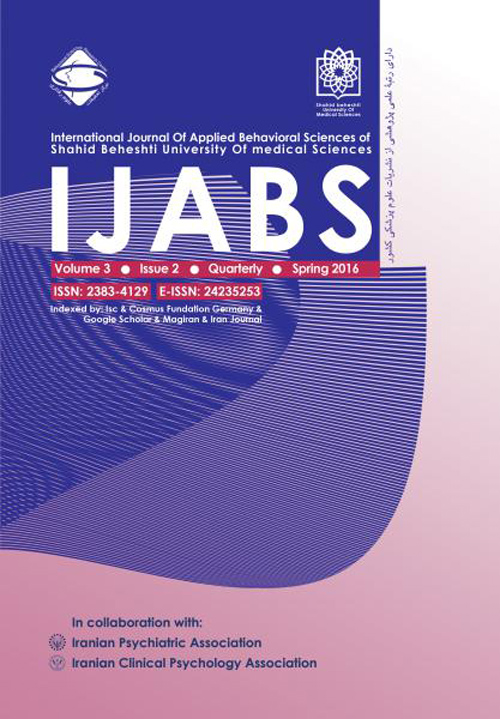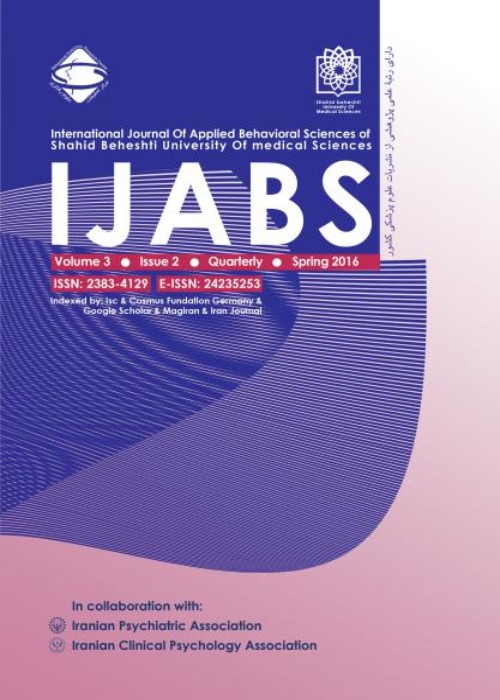فهرست مطالب

International Journal of Applied Behavioral Sciences
Volume:4 Issue: 1, Winter 2017
- تاریخ انتشار: 1396/01/30
- تعداد عناوین: 6
-
-
Pages 1-7IntroductionThe present study gives an account of the effects of Triple P, positive parenting program, on parenting styles as well as the attitude towards strengths and difficulties of the child.MethodsThis study is a clinical trial, which sets out to explore the effects of psychiatric disorders on 30 parents parents of teenagers being admitted to Imam Hossein Hospital, Tehran, Iran based on the diagnosis of child psychiatrist, teenagers with psychiatric disorders were studied in two groups: trial and control. Positive parenting program i.e. Triple P sessions were held for the trial group while the control group received usual clinical services.ResultsBased on the results of the present study, after holding 3P sessions, Baumrind`s parenting styles scores show some improvement in comparison with previous test scores; however, the difference was not statistically significant (p=0.167). The overall score of the child`s strengths and difficulties questionnaire, that was completed by the parents, represents a statistically significant difference (p=0.02) between the test scores before and after the intervention.ConclusionIt is important to note that positive parenting interventions can improve and, at the same time, change parenting styles. Moreover, Triple P can change parents` attitudes concerning the strengths and difficulties of the child, not to mention improving their parenting styles. Our results are consistent with those of similar studies on children. Declaration of Interest: NoneKeywords: Parenting styles, Positive parenting program (Triple P), Parenting, Parent-child relations
-
Pages 8-14Introductiongeneralized anxiety disorder (GAD) is the most common type of anxiety disorder and has high rates of comorbidity with other psychiatric disorders. Sever anxiety is the main diagnostic criteria for GAD.The purpose of this study was to investigate the effectiveness of cognitive self-compassion training on self criticism and academic achievement in second grade female high school students with GAD.MethodsThe present experimental study included pre-test, post-test with the control group design. The statistical population of this study consisted of all female second grade students of high schools in Izeh city in the academic year of 2015-2016. Screening was conducted and 302 participants completed the Penn State Worry Questionnaires, Then 40 individuals suffering GAD identified and were assigned randomly to experimental and control groups. The instruments used in this study was Slef-Criticism Questionnaire and student's average scores were used to measure academic achievement. The experimental group received self-compassion training for ten 90-minutes sessions, one session in a week lasting for two months. Analysis of the data was done using descriptive and inferential tests such as covariance analysis was conducted.ResultsExperimental group showed significant decrease in self-criticism after being Trained (PConclusionBased on the result we can say that cognitive self-compassion training is an important factor in reducing self-criticism and to improve academic achievement in students suffer from GAD.Keywords: cognitive self-compassion, self-citicism, academic acheivement, generalized anxiety disorder
-
Prevalence of sensory processing disorder among children between ages of 5 to 11 years old in TehranPages 15-20Backgroundthe aim of this study was Compare sensory status of children 5 to 11 years in Tehran, according to the age and gender based on sensory profile questionnaire.MethodsIn this cross-sectional study, 2191 children from 5 to 11 years in Tehran were selected using random cluster sampling. The survey questionnaire was used in sensory profile. Information collected from these children using statistical methods, Kolmogorov - Smirnov, Mann Whitney Welch and ANOVA were used, in all testes less than or equal to 0.05 was considered significant.ResultsMost of the people involved in sensory processing disorder, sensory sensitivity factor and lowest factor involved in fine movement/perception. The results of Mann Whitney showed that the middle of the factor of sensory sensitivity, emotional reaction, and oral sensory sensitive, inattention and destructibility, sensory sensitivity and fine movements / perception both males and females differ significantly (PConclusionThis study is the first evidence of significant differences in the pattern of sensory processing in children without disabilities provides and according to the impact of the disorder on the quality of life of children and their adverse effects on the children's personal and social life, Screening school-aged children and trying to treat it is necessary.Declaration of Interest: None.Keywords: Sensation Disorders, Sensation, Child
-
Pages 21-27BackgroundDiagnosis and treatment of anxiety and depression during the early stages of chronic kidney disease is very important. This study aims to assess the true pattern of symptoms of depression and anxiety in hemodialysis population in the city of Qazvin.MethodsFor this purpose, 80 individuals (40 hemodialysis patients and 40 individuals as the control group) have participated in this study. All participants completed Beck Depression Inventory and Cattell Anxiety Inventory. Additionally, clinical status, socio-economic and demographic variables of patients have been collected and analyzed by appropriate statistical methods.ResultsIn examining the variables of depression in terms of the maximum mild depression there has been 14 hemodialysis patients (35%) versus 34 (85%) individuals from the control group, in terms of moderate depression-severe index there has been 26 (65%) versus 6 (15%), (pConclusionThe current study showed that the prevalence of depression and anxiety in hemodialysis patients are significant and correlates with clinical variables, so for improving this clinical concern, effective interventions for mental health should take place and the impact of these interventions should be investigated.Keywords: Kidney Diseases, Dialysis, Depression, Anxiety
-
Pages 28-39IntroductionOn the one hand, there are contradictory evidence on the effects of emotion regulation strategies on intrusive thoughts and on the other hand, the effect of alternative strategies, such as acceptance on retrieval of autobiographical memory has not been extensively studied yet. Hence, this research aimed to investigate the influences of thought suppression, and acceptance on intrusive thoughts in non-clinical sample.MethodsA quasi-experimental design was adopted with 66 participants that were randomly assigned to 3 groups (thought suppression, acceptance, and control group). Participants answered to some questionnaires. Then, a clip and a related instruction were presented for each group. They were asked to perform according to instruction after movie and put in a tick in a paper whenever the thoughts of movie come to their mind. Reults were analysed using ANOVA in SPSS.ResultsResults indicated that there is a significant differences between groups, and striking differences were between the acceptance group and thought suppression.Conclusionthis result is consistent with the hypothesis that avoidance is a short term, useful emotion regulation mechanism. Although acceptance led to a significant increase of intrusive thoughts, it may have beneficial impacts on mood. Results are discussed in terms of cross-cultural findings.Keywords: Thought suppression, Acceptance, intrusive thoughts
-
Pages 40-46IntroductionThe Hamilton Rating Scale for Depression (HAM-D) has not been tested for the psychometric properties in Belarusian population. In this regard conducting psychometric assessment of the HAM-D used in Belarusian population has special importance. The aim of this study was to investigate and improve the psychometric properties of the HAM-D applying in Belarusian population through Rasch analysis.MethodsData from 551 Belarusian patients with confirmed diagnosis of depression were used in this study. The Partial Credit Model was used in the psychometric analysis.ResultsThe analysis of item-person map showed disagreement between distributions of person measures and item categories. Only 8 items had appropriate values of Rasch fit-indexes. I have improved the psychometric properties of the HAM-D. Five items with bad values of fit-indexes were recombined into two new items. New items were added to the remaining 8 items with acceptable fit-indexes values and then Rasch analysis was repeated. All items showed adequate construct validity. The person separation index (PSI) for original HAM-D was 2.32. The person reliability was 0.84. Reliability analysis of the final model included 10 items showed higher estimates: the PSI was 3.61, the number of strata rose to 5.14, the person reliability was 0.93.ConclusionThis study revealed that the HAM-D applied in Belarusian population has several psychometric problems. After removing invalid items and changing score rules of bipolar items psychometric properties of the scale were improved. Declaration of Interest: None.Keywords: Rasch analysis, Hamilton Rating Scale Depression


